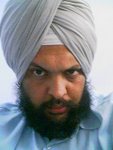.jpg)
.jpg)
.jpg)
.jpg)

It was kind of late evening, the match on the IPL was so boring that anything would be better than having to go through another hour of that muck and I was feeling kind of alone. So I decided to go out and have a bit of a walk and take in some fresh air. So I got into my car, and drove out trying to find a place where I could take a walk. I suppose the carbon footprint of the drive is bigger than the walk but that is another matter. As I drove past the War Memorial opposite the Secretariat, I thought I might as well take a look at the memorial. I had never been there before. As I parked the car and got out, something crunched under my foot. There was enough light to see that it was a carton of medicine. As I picked it up, I could read that it had once contained Misoprostol. I tried to remember what it is used for when I recollected that it is a drug used for inducing first trimester abortions. I threw the carton away and took a couple of rounds in the park and saw the war memorial. So many men have died, and I could feel that maybe some of them were out there visiting the place. There were a few people around, couples, and groups of boys with songs playing on their mobile phones.
I wondered why someone decided to take a misoprostol tablet at the war memorial rather than any other place. Maybe, it was a war too that led to the ingestion of the tablet. I walked on the soft track made up of cinders and it was kind of nice and soft under my feet. kind of springy.
I reached back home and took of my shoes and saw that the distal half of my left foot had turned black. I thought maybe I had developed an acute diabetic foot or something when I realized that it was the ash that had seeped through a hole in the sole of my shoe. And I love those shoes, I wonder where I will get a replacement.







1 comment:
I am sure India didnt have such dilemmas as Australians when they built War Memorials. However I am not sure about abortions.
In Australia, in 1981, historian Henry Reynolds raised the issue of whether war memorials should be erected to Indigenous Australians( Aboriginal) who had died fighting against British invaders on their lands.
"How, then, do we deal with the Aboriginal dead? White Australians frequently say that 'all that' should be forgotten. But it will not be. It cannot be. Black memories are too deeply, too recently scarred. And forgetfulness is a strange prescription coming from a community which has revered the fallen warrior and emblazoned the phrase 'Lest We Forget' on monuments throughout the land. [...] [D]o we make room for the Aboriginal dead on our memorials, cenotaphs, boards of honor and even in the pantheon of national heroes? If we are to continue to celebrate the sacrifice of men and women who died for their country can we deny admission to fallen tribesmen? There is much in their story that Australians have traditionally admired. They were ever the underdogs, were always outgunned, yet frequently faced death without flinching. If they did not die for Australia as such they fell defending their homelands, their sacred sites, their way of life. What is more the blacks bled on their own soil and not half a world away furthering the strategic objectives of a distant Motherland whose influence must increasingly be seen as of transient importance in the history of the continent".
Post a Comment